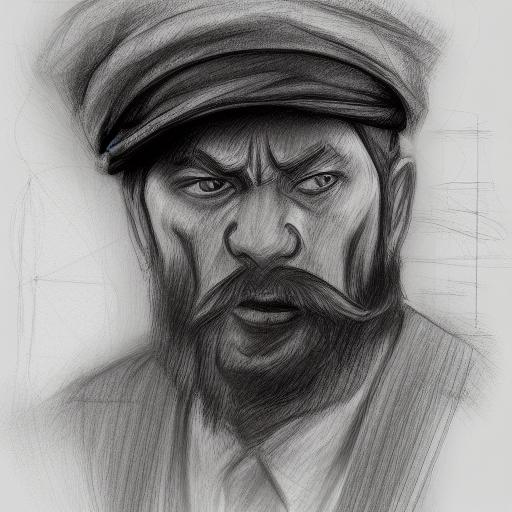How to write this prompt?
Here is a breakdown of the different parts of the prompt and how they influence the generated image:
- Rough sketch/pencil sketching: This part of the prompt sets the tone for the overall style of the image. It suggests that the image should have a hand-drawn feel, with visible pencil lines and texture.
- Weeping man with a beard: This is the subject of the image. It gives the AI a clear idea of what to focus on and what the central figure of the image should look like.
- Newsboy hat: This is a specific detail that adds character to the image. It gives the AI more information to work with and can help make the image more memorable and distinctive.
- Pencil sketch by Bencho Obreshkov: This is a reference to a particular artist’s style. It suggests that the image should have a similar look and feel to Obreshkov’s work, which includes a lot of detail and texture.
- Artstation/digital art: These are references to the medium and platform on which the image will be created and shared. They help the AI understand the context and purpose of the image.
- Sketch style/realistic sketch/art sketch: These are additional descriptors that help clarify the overall style and tone of the image. They give the AI more information to work with and help ensure that the image is consistent with the desired aesthetic.
Overall, each individual part of the prompt contributes to the overall image in a specific way. By including details like the subject, style, and medium, you can give the AI more information to work with and ensure that the generated image meets your specific needs and preferences.
What is the difference between a rough sketch and a polished sketch?
A rough sketch is a preliminary drawing that is typically done quickly and without much detail, intended to capture the overall composition and basic shapes of the subject. A polished sketch, on the other hand, is a more finished version of the same drawing, with more refined lines, shading, and details. The rough sketch is usually used as a starting point for the polished sketch, and may be modified or discarded entirely in the final drawing.
How to create a realistic sketch using digital art software?
To create a realistic sketch using digital art software, you will need to start with a rough sketch of the subject, using a pencil or pen tool in the software. Once you have the basic outline and shapes of the subject in place, you can begin adding layers of shading and texture using digital brushes that mimic traditional drawing materials like charcoal or graphite. Paying attention to lighting and shadow can help create a more realistic appearance, as well as using a variety of line weights and strokes to create depth and dimension.
Why is the choice of subject important in a pencil sketch?
The choice of subject is important in a pencil sketch because it determines the level of detail and complexity required in the drawing. A simple subject like a single object or a simple landscape may require less detail and shading than a complex subject like a portrait or a cityscape. Additionally, the subject can convey a particular mood or emotion that can be enhanced or reinforced through the use of certain drawing techniques or styles. Choosing a subject that resonates with the artist can also make the drawing process more enjoyable and satisfying.
Can AI-generated art be improved or edited by humans?
Yes, AI-generated art can certainly be improved or edited by humans. While AI can produce impressive and often unique results, it is still limited by the algorithms and data it has been trained on. Humans can provide additional input, feedback, and creativity to help refine and enhance the output of AI-generated art. Some ways that humans can improve or edit AI-generated art include:
- Adjusting color, lighting, and other visual elements
- Adding or removing specific details
- Combining multiple AI-generated images into a single piece
- Using traditional art techniques to add texture or depth to an AI-generated image
- Providing feedback to the AI algorithm to help it learn and improve over time
What are the best tools and platforms for creating AI-generated art?
There are a variety of tools and platforms available for creating AI-generated art. Some of the most popular options include:
- StyleGAN: A popular tool for creating realistic images based on a set of input parameters or images.
- Deep Dream: A tool developed by Google that uses neural networks to create surreal and dreamlike images.
- Runway ML: A platform that provides access to a variety of AI models and tools for creating images, videos, and more.
- Artbreeder: An online platform that allows users to mix and match different art styles and images to create unique combinations.
- Adobe Creative Cloud: Adobe has integrated AI features into several of their products, including Photoshop and Illustrator, that can be used to enhance or modify images.
Ultimately, the best tools and platforms for creating AI-generated art will depend on your specific needs and preferences. It’s worth experimenting with different options to find the ones that work best for you.
Visualize your ideas like never before with the power of AI-generated art and design tools from Visual Paradigm Online. Elevate your designs to the next level by effortlessly integrating stunning graphics with just a few clicks. With a user-friendly interface and a vast selection of design templates and assets at your disposal, you can explore and experiment with various styles and layouts until you create the perfect masterpiece. Discover the limitless potential of AI-generated art and transform your creative vision into reality with Visual Paradigm Online.


